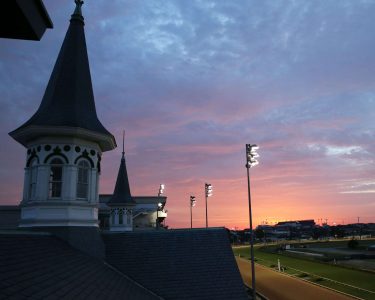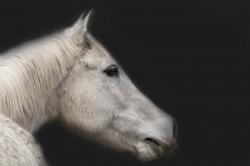A Most Surprising Derby: Canonero II’s ‘Derbygate’ of 1971
By Maryjean Wall
A theme of starting gates and stable gates stood central to the 1971 Kentucky Derby, an oddity that could describe that year’s 97th running as Derbygate.
It seems worth recalling during this 2020 season when Derby fever has taken on new meaning: the COVID-19 pandemic forced a postponement of the race from May to Sept. 5, adding its own odd tale to Derby lore.
So, to 1971: on the one hand you had the horse named One Eyed Tom (yes, he was a one-eyed horse) who couldn’t run straight from the gate. He made a U-turn back towards the starting gate upon commencing a workout designed to prove he was capable of racing.
It was all new to One Eyed Tom, as he’d trained on a ranch in Las Vegas and had never run in a race. But there he was, a one-eyed, unraced horse breaking from the gate to further prolong his owner’s Derby fever.
Alas, he only made it a few yards when he surprised everyone including his rider with the notorious U-turn. Leaving Las Vegas, he’d failed to perfect his gate work. Track stewards watched the starting gate debacle and denied him entry into the race.
Then onto the scene came Canonero II. He was turned away at the stable gate, so he nearly didn’t get as far into Churchill Downs as One Eyed Tom. For a few tense hours it looked like Canonero II, stuck at the gate, might have to return in his van to Miami, where he’d landed in quarantine after flying in from Venezuela.
Neither his trainer, Juan Arias, nor groom, Juan Quintero, spoke English. The guards at the stable gate did not speak Spanish. Imagine trying to talk your way into the barn area prior to America’s greatest race when the guards don’t know who you are, have not been expecting you, and are frustrated with the language barrier. Canonero waited. And waited. Somehow, as we all know, fate intervened.
Once inside Churchill Downs, Canonero II became the subject of Derby mockery in the week leading up to the race. He had a crooked leg and a crab-like way of galloping. This did not endear him to Derby fans and oddsmakers. Though bred in Kentucky, he was a nobody to Americans, coming from Venezuela in those days before the Internet rendered the globe a smaller place.
Not everyone knew his story. With six wins in 12 starts, Canonero II (yes, there had been a Canonero I in Mexico) became a Derby prospect after the mother of owner Pedro Baptista dreamed this horse would win the Kentucky Derby. Baptista, who owned some kind of pipe manufacturing business in Venezuela, had the money to indulge his mother’s Derby fever. The previous year, 1970, he had sent Canonero II to Del Mar, where the colt ran admirably: third in an allowance race, then fifth in the Del Mar Futurity. The colt returned to Venezuela. The following spring Canonero II was on his way back to the United States.
It was not an easy trip.
Trouble arose once he was airborne. Twice, the cargo plane had to turn back. The first time was due to mechanical problems. On the second attempt, the plane returned after an engine caught fire. Back in Caracas, Canonero was transferred to a plane carrying chickens. It was not a quiet or relaxing flight and this wore on the horse’s nerves.
Canonero’s nightmarish trip only got worse upon landing in Miami. He did not have the proper papers, so he was retained on the plane for some 14 hours. Naturally he became dehydrated. He looked like hell when he finally deplaned and entered quarantine. He lost weight and looked even more hellish when he emerged from lockdown four days later for his trip north.
His connections decided they would not risk sending him by plane to Churchill Downs after what had happened leaving Caracas. Consequently, Canonero made the journey by van and this was how he arrived at Churchill Downs, where his trainer and groom realized there might not be room at the inn.
Communications had reached a language impasse while Canonero sweltered inside the van. This delay caused him to lose 70 to 80 pounds before Churchill Downs finally allowed him inside the gate and gave him a stall. Trainer Arias told track officials the colt’s energy had become so depleted with the journey that he might not be able to start in the Derby.
Arias knew what he was doing. He took Canonero for long walks around the barn area to restore his interest and his energy. He also sent him out on the track for long gallops. He worked him, but not fast. The Derby oddsmaker relegated what everyone had come to think of as a slow Canonero to a mutual field of six horses in the betting, a sort of insult implying that none in the field had much of a chance.

Sunrise at Churchill Downs – Courtesy of Churchill Downs/Coady Photography.
But Canonero had something going for him that no one knew about. Arias sent him through a secret blowout the day before the Derby, a three-furlong work in a snappy 36 seconds that went unobserved before anyone else was on the track. By the time the sun came up Canonero was Derby-ready. Not until two years later did anyone learn about the secret workout, as Jim Bolus revealed in his book, Run for the Roses.
As far as the world was concerned, Canonero II was still a long shot. He’d been 500-1 in the Caliente future book and closed there at 100-1. His on-track odds in the mutuel field were $8.70 to $1, making him a modest long shot in the race.
The starter planned to have Canonero blindfolded when he entered the Derby starting gate. Perhaps the starter had already had enough of One Eyed Tom’s gate antics earlier in the week. He was taking no chances with this Venezuelan horse who was unfamiliar to the Churchill Downs gate crew. So, into the gate Canonero II went while blindfolded with a cloth that an assistant starter would whip off the horse’s face at the break.
The bell rang and they were off. Jockey Gustavo Avila brought Canonero II from way back in the field to win by 3 1/4 lengths, paying $19.40 to win. Surprise and shock went through Churchill Downs like a streak of unexpected lightning.
The odd Derbygate of 1971 was now in the books, Canonero II became a national hero in Venezuela and One Eyed Tom disappeared presumably back home to Vegas from whence he never should have left.

Maryjean Wall is the former turf writer for The Lexington Herald-Leader. She retired from that publication following a career that spanned four decades and included three Eclipse Awards and an AP Sports Editors Award. She holds a Ph.D. in U. S. History, has taught history at University of Kentucky, and continues to write about horse racing as a free-lancer. She has been published in Sports Illustrated, Wall Street Journal, Forbes Life, Cincinnati, and Keeneland, among other publications. She has authored two books focused on horses and racing: How Kentucky Became Southern: a Tale of Outlaws, Horse Thieves, Gamblers, and Breeders; also, Madam Belle: Sex, Money, and Influence in a Southern Brothel. When she is not writing, she is photographing, always pursuing the creative muse.


